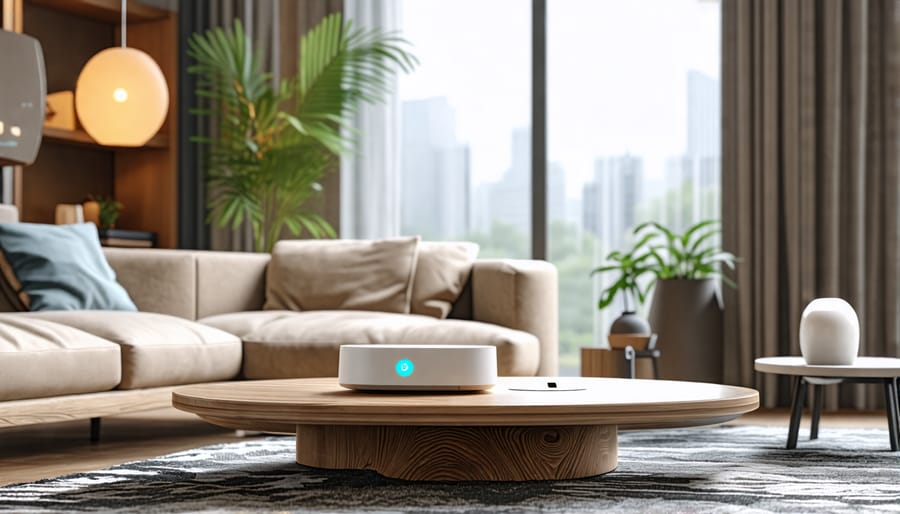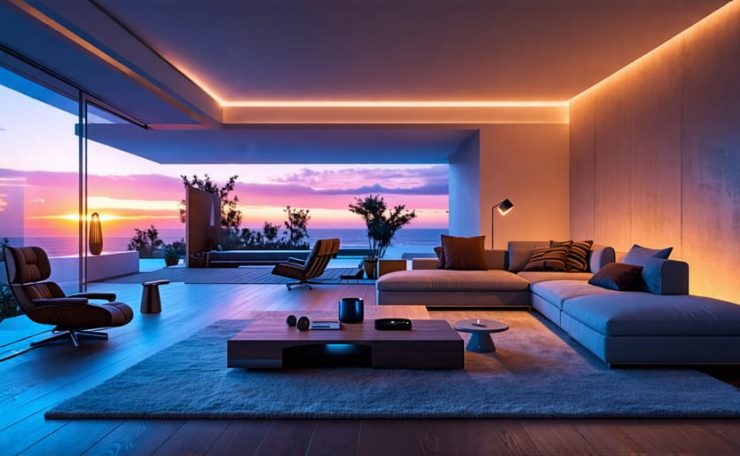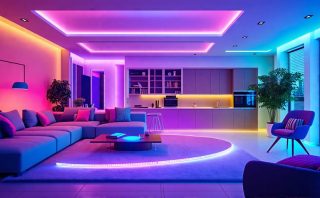Install smart bulbs compatible with voice control platforms like Alexa, Google Assistant, or Siri to transform your space with intelligent illumination. Optimize your lighting design by integrating smart hubs that allow centralized control over multiple devices, ensuring seamless connectivity across your home or business. Evaluate lighting solutions by comparing features such as energy efficiency, compatibility with existing systems, and ease of installation to choose the best fit for your needs. Enhance ambiance with specific voice commands for different settings, from dimming lights for movie nights to brightening spaces for work or events, offering ultimate convenience and flexibility.
The Evolution of Lighting Technology
From Manual to Smart Lighting
The evolution from manual to smart lighting signifies a remarkable shift in how we illuminate our spaces. Traditional lighting required physical interaction, limiting flexibility and efficiency. Today, smart lighting technologies offer unprecedented control and convenience. With voice activation, adjusting brightness and ambiance is seamless, enhancing daily living and design aesthetics. This shift not only simplifies operations but elevates the user experience by integrating with other smart home devices. Homeowners and professionals alike can now implement tailored lighting solutions that are both aesthetically pleasing and functionally superior, marking a new era in lighting innovation.
Integration with Smart Home Systems
Voice-activated lighting seamlessly integrates with smart home systems, enhancing convenience and energy efficiency in any space. By connecting to platforms like Amazon Alexa, Google Assistant, or Apple HomeKit, users can easily control lighting with simple voice commands—adjusting brightness, color, and even scheduling. This integration allows homeowners, interior designers, and architects to create personalized lighting experiences tailored to specific moods or activities without ever touching a switch. Easy compatibility with existing devices ensures a smooth setup process, offering both comfort and flexibility in modern lighting solutions.

Benefits of Voice Activated Lighting
Convenience and Accessibility
Voice-activated lighting offers a seamless integration of convenience and accessibility into any space, revolutionizing how homeowners and professionals manage their lighting environments. By simply using voice commands, users can control lighting preferences without the need for physical switches or even a smartphone app. This hands-free operation is particularly beneficial for individuals with mobility challenges, ensuring accessible control over lighting for everyone. For homeowners and businesses alike, voice control enhances daily routines, allowing for quick adaptation to changing needs, whether setting the mood for a dinner party or adjusting lighting intensity for focused work sessions.
The integration of voice-activated lighting systems also eliminates the hassle of managing multiple devices, facilitating streamlined interactions with other smart home features. This compatibility ensures that even technologically inexperienced users can effortlessly enhance their space’s functionality. Furthermore, for commercial business owners and event planners, voice-activated lighting promotes efficiency, enabling quick adjustments during events or meetings with minimal disruption. As a forward-looking solution, it provides personalized convenience and enhances the overall accessibility of lighting systems in both residential and commercial settings.

Energy Efficiency and Cost Savings
Voice-activated lighting offers a promising solution for enhancing energy efficiency and reducing utility costs. By integrating voice control with your lighting system, you can seamlessly manage when and where lights are on, thus minimizing unnecessary energy consumption. This technology allows users to turn lights off in unoccupied rooms or dim them during daylight hours, ensuring that energy is used only when and where it’s truly needed.
Moreover, voice-activated systems can be programmed to follow schedules and incorporate smart sensors, offering personalized lighting solutions without manual intervention. This leads to a substantial reduction in electricity use, translating into noticeable cost savings on utility bills. For homeowners and commercial business owners alike, adopting this technology not only supports sustainable living but also provides an edge in managing overhead costs efficiently. By choosing a voice-activated lighting system, you’re investing in smarter, eco-friendly energy use that aligns well with modern needs for convenience and sustainability.
Designing Spaces with Voice Activated Lighting
Customizing Ambiance
Voice-activated lighting offers a revolutionary way to tailor the ambiance of any room with just a simple command. For homeowners, this technology allows the seamless transition between vibrant, energizing light for productivity and soft, calming hues for relaxation. Interior designers and architects can leverage this feature to create dynamic environments that adapt to different times of the day or activities, enhancing the aesthetic appeal and functionality of living spaces. Event planners can effortlessly alter lighting schemes to match event themes, from elegant dinners to lively parties, ensuring a memorable experience for attendees. In commercial spaces, business owners can use voice-activated lighting to set the perfect tone for customer interactions or employee work environments, whether that’s invigorating daylight for focus or warm tones for a welcoming atmosphere. This customization capability empowers users to curate spaces that both reflect personal style and serve practical needs, making voice-activated lighting an invaluable tool in modern design and functionality.
Case Studies: Residential and Commercial Applications
Voice-activated lighting systems have revolutionized both residential and commercial environments, providing personalized control and enhancing convenience. In residential settings, these smart systems have been seamlessly integrated into homes by allowing residents to adjust lighting levels and create moods with simple voice commands. For instance, a homeowner can activate different lighting scenes in various rooms, such as mood lighting for the living room or task lighting in the kitchen, by effortlessly interacting with their smart home assistant.
In the commercial sector, voice-activated lighting has proven to be invaluable in increasing efficiency and creating dynamic workspaces. An office building in New York implemented voice control not only to streamline routine operations but also to enable hands-free command over conference room lighting settings during presentations, optimizing the professional environment. Retail stores are also leveraging this technology to adjust lighting based on the time of day or promotional activities, enhancing customer experience while simultaneously conserving energy.
These successful case studies highlight how voice-activated lighting offers tailored, practical solutions that are both sophisticated and user-friendly. Whether for a cozy home ambiance or efficient business operations, the integration of voice control into lighting systems demonstrates significant benefits, emphasizing its role as a forward-thinking lighting solution.
How to Choose the Right Voice Activated Lighting System
Key Features to Look For
When selecting a voice-activated lighting system, consider compatibility as a top priority. Ensure the system integrates seamlessly with popular virtual assistants like Amazon Alexa, Google Assistant, or Apple HomeKit. This compatibility allows for smooth operation and enhanced user experience. Look for adjustable brightness and color temperature features that can create the perfect ambiance for various spaces, from cozy lounges to vibrant home offices. An intuitive app interface that allows for customization and scheduling of lighting scenes is essential for maximizing convenience and energy efficiency.
Security is another critical aspect. Choose a system with robust encryption protocols to protect your network from unauthorized access. Additionally, check for reliable connectivity options, such as Wi-Fi or Bluetooth, to ensure consistent performance. Scalability is important for future expansion, so opt for solutions that support multiple lighting devices. Lastly, consider systems with energy monitoring capabilities to keep track of consumption patterns and help reduce utility costs, making it a smart investment for both residential and commercial settings.
Comparing Leading Brands
When it comes to choosing voice-activated lighting, homeowners and professionals have several leading brands to consider, each offering distinct features. Philips Hue stands out for its sophisticated integration with smart home systems and broad compatibility with voice assistants like Alexa and Google Assistant. Its high-quality bulbs can create custom scenes and schedules, providing both practicality and ambiance. Lutron’s Caseta is another favored option, known for its reliable performance and elegant design, appealing to those who value aesthetics alongside functionality. This brand also provides premium options suitable for commercial spaces and integrates seamlessly with major smart home ecosystems. Meanwhile, the Leviton Decora range impresses with its affordability and ease of installation. It supports multiple protocols, making it versatile for different project requirements. Evaluating these brands, your decision should align with personal lighting preferences, considering factors like compatibility, installation procedure, and desired control nuances for an optimal lighting solution.

Installation and Maintenance Tips
When installing a voice-activated lighting system, start by selecting a compatible hub, such as Amazon Alexa or Google Home, to centralize control. Ensure that your lighting fixtures support voice activation, often indicated by compatibility labels. For optimal placement, install smart bulbs and switches within range of your Wi-Fi network to prevent connectivity issues. During installation, follow the manufacturer’s instructions carefully, and consider hiring a licensed electrician if you’re unfamiliar with electrical work.
Regular maintenance is key to ensuring your system runs smoothly. Begin by updating the software for your smart hub and associated apps to benefit from the latest security enhancements and features. Periodically check for firmware updates for your lighting devices to fix bugs and improve performance. Clean the dust from your light fixtures to maintain brightness and check for any connectivity lags, which can often be resolved by resetting your router or hub. Lastly, if you experience persistent issues, a factory reset of your devices may resolve many problems, restoring them to their original operational status.
By staying proactive with installation and maintenance, you can enjoy the convenience and efficiency of a voice-activated lighting system with minimal disruptions.
Conclusion
Voice-activated lighting is set to revolutionize modern spaces by combining convenience with innovation. This transformative technology not only enhances aesthetic appeal but also elevates functionality, making it an attractive option for homeowners, designers, and commercial entities alike. With the ability to control lighting through simple voice commands, users experience unprecedented ease and efficiency. This integration can significantly improve the atmosphere of any environment, from intimate residential settings to expansive commercial venues. By considering design elements and installation tips provided, stakeholders can effortlessly implement these systems, optimizing their lighting solutions to meet unique needs and preferences. Voice-activated lighting blends seamlessly into the evolving landscape of smart home technology.





